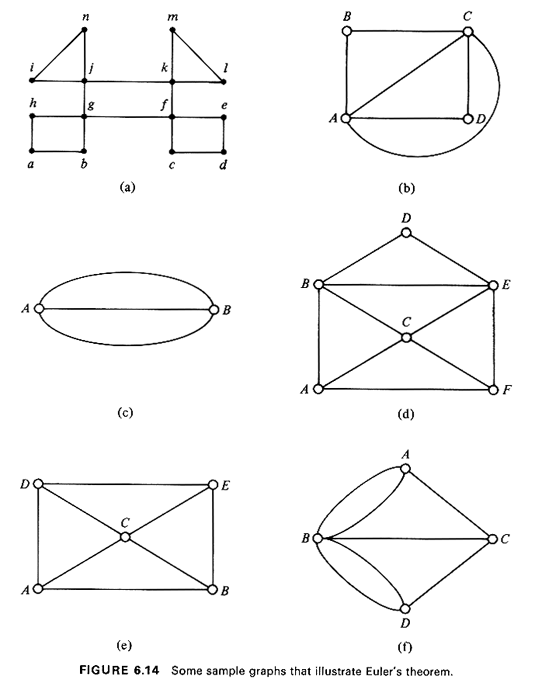


6.4.2 Chinese Postman's Problem on an Undirected GraphAssume that an undirected graph G(N, A) is given with known edge lengths
Find a circuit that will traverse every edge of G at least once and for
which the sum

where n(i, j) is the number of times edge (i, j) is traversed. The following definitions are now necessary for our subsequent discussion: Definitions: An Euler tour is a circuit which traverses every edge on a graph exactly once (beginning and terminating at the same node). An Euler path is a path which traverses every edge on a graph exactly once. We then have the following fundamental result: Euler's Theorem: A connected graph G possesses an Euler tour (Euler path) if and only if G contains exactly zero (exactly two) nodes of odd degree.12 Figure 6.14 illustrates Euler,s theorem. Figure 6.14a and b have no nodes
of odd degree and must, therefore, possess an Euler tour. Such a tour, for
instance, is the circuit {B. C, D, A, C, A, B} for the graph of Figure 6.14b
(note that the A-C-A portion of the tour can be traversed in either of two
ways). Graphs 6.14c and d have exactly two nodes of odd degree. Thus, they
must possess an Euler path according to the theorem. For instance, {A, B, D, E
C, A, F, C, B, E, F} is an Euler path for graph 6.14d. (By the way, Euler paths are
simple but not always elementary.) However, it is impossible to find an Euler path
that does not begin at A and terminate at F, or begin at F and terminate at A.
Finally, graphs 6.14e and f have four nodes of odd degree, and thus neither
an Euler tour nor an Euler path can be drawn on either. Note that graph 6.14f is
a network model of the Konigsberg problem with the seven bridges.

Proof of Euler's theorem: Assume that G has zero nodes of odd degree. It can then be shown that this is a necessary and a sufficient condition for an Euler tour to exist. It is necessary because any Euler tour drawn on the graph must always enter a node through some edge and leave through another and all edges on the graph must be used exactly once. Thus, an even number of incident edges is required for every node on the graph. Sufficiency, on the other hand, can be shown through the following
tour construction argument. We begin at some initial node j0
This procedure may now be continued until eventually, say after the kth step, there will be no edges left uncovered. At that time, an Euler tour will also have been obtained which will be a combination of circuits C0, C1, C2, . . ., Ck. The tour is constructed in the manner explained above for C0 and C1. It is interesting to note that the tour-construction approach that we have just outlined in proving sufficiency happens, in fact, to be one of the possible algorithms that can be used in practice to construct Euler tours on graphs.
What are now the implications of Euler's theorem for the Chinese postman's problem ? First, and obviously, if a graph possesses an Euler tour, then this tour is clearly the solution to the Chinese postman's problem. More important, however, as we shall now see, Euler,s theorem provides the guidelines for solving the Chinese postman,s problem, even for graphs on which an Euler tour does not exist. The solution approach basically consists of augmenting these graphs in such a way that all odd-degree nodes are transJormed to even-degree nodes, which in turn means that an Euler tour can be drawn on the augmented graph. Before discussing the details of this solution approach, we shall present an algorithm for drawing Euler tours on graphs where such tours are known to exist. 12In the case of directed graphs, Euler's theorem requires that the indegree and outdegree of each node must be equal to exist (see Problem 6.6). |